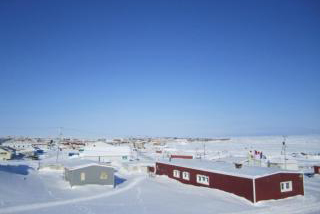My third novel The Blue Light Project was published in March/April and book business, touring etc, consumed most of those two months.
In May I had to get back to work. That means magazine work. And that means travel. I still very much enjoy this aspect of my freelance life. This time around in particular, I had an unusual schedule that took me to Igloolik, in Nunuvut, which is in Canada’s arctic…

…and then to Dubai and Abu Dhabi, 9000 kilometers away in one of the hottest desert areas known to man.

The experience generated plenty of stark contrasts, as you might imagine. -40 C versus +40 C is perhaps the most obvious. Ditto the landscapes of frozen snow and hot sand. But there’s also the area of wealth and development, where Dubai’s skyline seems to grow while you watch it and Igloolik is a clutch of low buildings along a remote stretch of beach in the Canadian high arctic. An international hub in the middle east versus an isolated hamlet in the frozen north. What two places could be more different?
And yet a couple of things struck me powerfully as being shared by these places. Both the Emiratis and the Inuit are ancient people, whose entrance into post-modernity has been relatively sudden. And in both places I was there to interview people whose lives are crucially connected to the project of staying in touch with ancient ways.
In the north, that person was Zacharius Kunuk, the legendary Inuit filmmaker who brought us the films The Fast Runner and The Journals of Knud Rassmussen.
Kunuk is a fascinating individual, whose committment to Inuit tradition comes paired with a fully post-modern engagement with technology and global thinking. I look forward to writing a profile of him and his work for an upcoming issue of Canadian Art.
In the United Arab Emirates, meanwhile, I was there to write several pieces that will run in Spafax Canada publications. But one of those assignments allowed me to meet Peter Bergh, one of the best known falconers in the world.

Falconry is a 2500 year old tradition in the middle east, and in a culture that isn’t easy to penetrate for western outsiders, it offers a fascinating window into the history of the region. I’ll be writing about Peter and the experience of working with his birds in an upcoming issue of Fairmont Magazine.

